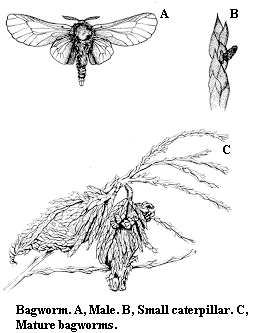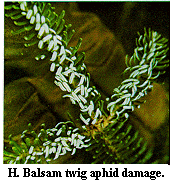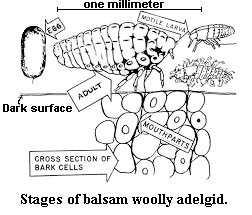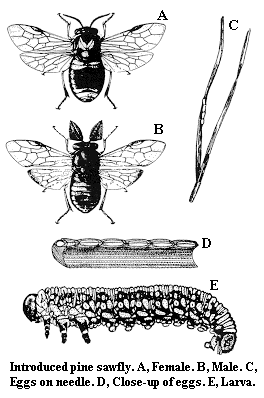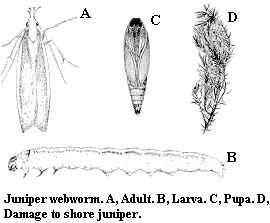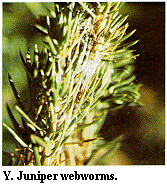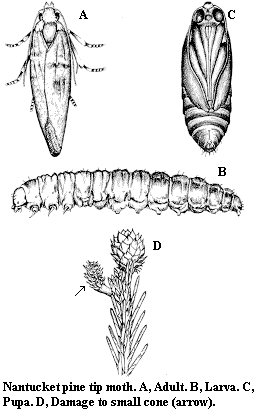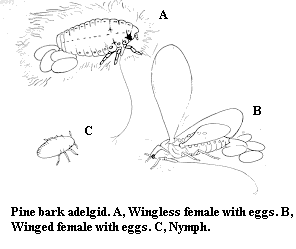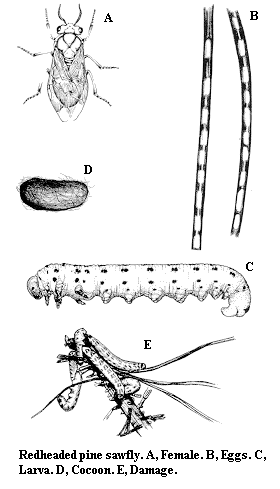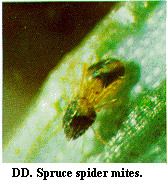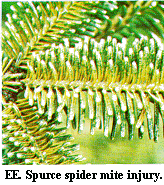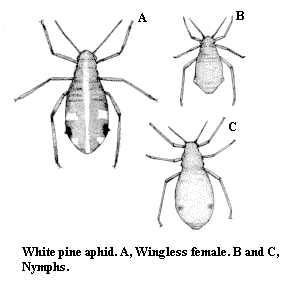Key to Conifer Pests
Included in this section are pests that infest arborvitae, cedar, deodar cedar, fir, hemlock, juniper, pine, and spruce in nurseries and in the landscape. Conifers form a major portion of the shrubs grown by commercial nurserymen. With their amazing variety of forms and shades of green and yellow, conifers are among the most important landscape plants. Although conifers generally require little care, they are occasionally damaged or killed by insects and spider mites in the landscape.
- Arborvitae leafminer – Arborvitae leaves are tunneled and brown; heavily infested shrubs are unthrifty and defoliate prematurely; tiny (1- to 3-mm), greenish or brownish caterpillars are found in tunnels.
- Bagworm – Spindle-shaped silk bags covered with pieces of plant foliage hang from twigs; when bagworms are numerous, much of the plant may be defoliated and may die.
- Balsam twig aphid – Needles of Fraser fir twisted and curled; bark may have a roughened appearance; aphids are bluish gray but are present only very early in the growing season.
- Balsam woolly adelgid – Gouty and twisted new growth of fir; needles defoliating prematurely; small, cottony fluffs on the bark of trunk and branches with small, bluish-black insects underneath; heavily infested trees declining or dead.
- Eastern spruce gall adelgid – Pineapple-shaped galls at the base of new twigs; growth distorted at older galls; small, greenish-white aphids in new galls.
- Introduced pine sawfly - Colonies of grayish caterpillars with rows of black and yellow spots on sides feed on white and Virginia pines. Heavily infested trees may be defoliated.
- Juniper webworm – Foliage of junipers webbed together by silk strands; heavily infested shrubs with much dead foliage incorporated in the webbing and dead foliage below the shrub; slender, whitish worms with brown stripes in webbing.
- Nantucket pine tip moth – Dead buds and shoots are hollowed out; small worms or pupae are inside. Small (up to 6-mm), gray moths may be noticed around dusk.
- Pine bark adelgid – Small (up to 3-mm), dark insects with conspicuous white, waxy filaments feeding on back. Most noticeable in late winter and spring.
- Pine needle scale – Needles of pine (sometimes balsam fir, Cedrus, Juniperus) infested with small (1 to 4-mm), white scale insects with light-yellow exuviae on one end.
- Redheaded pine sawfly – Colonies of yellowish caterpillars with brown spots and orange heads feeding on foliage; small shrubs may be completely defoliated.
- Spittlebugs – Masses of frothy liquid on twigs of pine. Twig dieback common.
- Spruce spider mite – Foliage pale yellowish or whitish; foliage may drop prematurely; spider mites may be present in large numbers; foliage may be webbed with fine silk webbing.
- White pine aphid – Large (up to 6-mm), dark, soft-bodied insects sucking sap from twigs and branches of white pine. Honeydew and sooty molds often present.
Arborvitae Leafminer
Arborvitae leafminer, Argyresthia thuiella (Packard), Yponomeutidae, LEPIDOPTERA
DESCRIPTION
Adult – The adult is a small (about 6-mm-long), light gray (with brown and black spots) moth with a wingspread of about 8 mm. The antennae are long and slender. The legs and abdomen are light brown (Figure A).
Egg – The egg is tiny (0.4 mm by 0.25 mm) and almond shaped with wrinkled sculpturing on one end. It is pinkish but turns darker as the embryo matures.
Larva – The larva is a small (0.75- to 3-mm), green (sometimes with a reddish tinge) or brownish caterpillar with a black head and cervical shield.
Pupa – The 3.5- to 4-mm-long pupa is greenish but turns brownish red as it matures. The tail segment has a group of six to eight short, stout hooks (the cremaster).
BIOLOGY
Distribution – The arborvitae leafminer is known from New England and eastern Canada south to the Middle Atlantic states and west to Missouri.
Host Plants – The arborvitae leafminer apparently confines its feeding to all varieties of arborvitae but seems to prefer American pyramidal, globe, and golden arborvitae (about in that order).
Damage – Mined leaves detract from the appearance of infested arborvitae (Figure A). Heavily damaged leaves may drop from the plant prematurely, and in extreme cases the plant may be killed.
Life History – Arborvitae leafminers overwinter as larvae in the mined leaves. Pupation occurs and adults appear in late spring and throughout the summer. After 2 or 3 days, females deposit eggs in the axils of branchlets or along leaf margins. A female may oviposit for 4 or 5 weeks. Most of the eggs are laid around the first of June. Newly hatched larvae bore into the leaves and feed for the rest of the season. The larvae mine from the tips of branchlets toward the bases and allow the frass to collect in the tunnels until winter. When mining is resumed the following spring, the frass is expelled from the mine. Larvae will sometimes leave old mines and begin new ones. Pupation occurs in the new portion of the mine after an exit hole has been chewed and takes place from March to May. The pupal stadium is 3 to 5 weeks. Pupae face the exit hole.
CONTROL
Some control may be obtained by pruning out infested tips in the fall. Hymenopterous parasites also help control the population. If a spray is used, it should be applied in early June or late May. For specific chemical controls, see the current state extension recommendations.
Bagworm
Bagworm, Thyrirlopteryx ephemeraeformis (Haworth), Psychidae, LEPIDOPTERA
DESCRIPTION
Adult – The female is wingless and grublike with tiny, useless legs. The male is a small, brown, hairy moth with clear wings.
Egg – The yellow egg is slightly oblong or spherical, about 0.8 mm by 1.0 mm. It is found in the mother's bag, usually in her pupal exuviae.
Larva – The male is 2 to 43 mm long; the female, 2 to 52 mm. The head and forward parts are dark and sclerotized the remainder is pale amber. Larval bags grow to about 5 cm long and 12 mm wide (Figure G).
Pupa – The pupa is dark brown. Males are slender posteriorly, and females are cylindrical. The pupal stage is spent inside the bag.
BIOLOGY
Distribution – Bagworms occur throughout the eastern United States.
Host Plants – Bagworms feed on many trees including maple, boxelder, sycamore, willow, black locust, elm, linden, poplar, oak, apple, wild cherry, sassafras, and persimmon; but the preferred hosts are conifers. Arborvitae is highly susceptible.
Damage – A single bagworm does relatively little damage. Yet because females do not fly, populations are often very dense; and excessive defoliation may actually kill conifers within one or two seasons. Damage is most noticeable on ornamental plantings rather than in forests and woodlands.
Life History – The bagworm is sometimes called the evergreen bagworm. Populations vary, but occasionally bagworms become extremely abundant, alarming homeowners. The winter is spent as eggs (500 to 1,000) in the mother's bag. They hatch in May and June, and the young worms drop from the bag on a slender silk thread. Such small worms may be "ballooned" for short distances on this long thread. In August, the worms mature and change into the pupal stage. During August and September, male moths emerge from their bags to mate, living 1 or 2 days. Female bagworms, living 4 to 9 days, do not leave the bag until the eggs are laid. Before the young worm feeds, it secretes silk and forms a bag. Bits of plant tissue become enmeshed in this bag when the worm feeds. As the worm grows, the bag enlarges, reaching about 5 cm when complete. It is fastened to the plant by silk manufactured whenever the worm rests or molts.
CONTROL
Where practical, bagworms can be removed with scissors or a sharp knife. Bagworms are parasitized by several ichneumonid and chalcid wasps. Low winter temperatures and bird predation on small larvae are also limiting factors. Chemical control is effective, particularly in June and early July when the bags are small. For specific chemical controls, see the current state extension recommendations.
Balsam Twig Aphid
Balsam twig aphid, Mindarus abietinus Koch, Aphididae, HEMIPTERA
DESCRIPTION
Adult – Stem mothers (fundatrices) are wingless, bluish gray aphids. Sexuparae and egg-laying adults (sexuales) have wings, five dark spots on the thorax, and four sclerites on the top of the abdomen. The honey tubes are indistinct.
Egg – The brown eggs are covered with small, white rods of wax. They are laid in crevices in the bark.
Nymph – The nymphs are small, pale yellowish-green, wingless aphids. Nymphs that develop into egg-laying adults are slender.
BIOLOGY
Distribution – Balsam twig aphids have been found from Maine to Washington and in both the Rocky Mountain and Appalachian Mountain regions. They apparently occur wherever balsam fir, white fir, and spruce are grown.
Host Plants – This aphid feeds on a wide variety of hosts, including balsam, Siberian, alpine, and Fraser firs; white spruce; and juniper.
Damage – Balsam twig aphids cause curled needles and roughened bark of infested Fraser firs (Figure H). Although trees may tolerate large populations, eventually they will decline in vigor. Most serious damage occurs in Christmas tree plantations, where appearance and market value of infested trees are degraded and reduced.
Life History – Balsam twig aphids are unique pests because of their confusing life cycle and short feeding time. Each generation is different from its parent generation, and only one generation each year lays eggs. Most of the year is spent in the egg stage in crevices of the bark. The eggs are laid in early summer, and they remain on the tree throughout the fall and winter. In early spring the eggs hatch and the first generation of nymphs develops into wingless aphids called stem mothers (fundatrices). The stem mothers give birth to live nymphs, which may develop into wingless forms called fundagenae or winged forms called sexuparae. The egg-laying adults (sexuales) are winged and are the offspring of either the fundagenae or sexuparae. All of this happens in the spring and early sum mer. By the end of June, the eggs have been laid and the adult aphids have disappeared.
CONTROL
Control of balsam twig aphids is difficult because the damage occurs in early spring when weather is unpredictable. For specific chemical controls, see the current state extension recommendations.
Balsam Woolly Adelgid
Balsam woolly adelgid, Adelges piceae (Ratzeburg), Phylloxeridae, HEMIPTERA
DESCRIPTION
Adult – The balsam woolly adelgid is a small (about 1mm), round, bluish-black or purple sucking insect covered by woolly strands of wax (Figure I). The mouthparts are long (1.5 mm) and slender. (They may break off when the insect is removed from the host.)
Egg – The ovoid, amber egg is usually found in a mass of waxy strands and eggs.
Nymph – The newly hatched nymph is called a crawler. It is a small (0.35-mm), amber, flattened insect with red eyes. As it matures, the older nymph generally resembles the adult except for size. The overwintering form (neosistens) of the crawler flattens itself to the bark and secretes a waxy fringe at the body margin.
BIOLOGY
Distribution – Apparently limited in its northern distribution by cold weather, balsam woolly adelgids infest firs in southern Canada, the Pacific Northwest, and the northeastern United States. They also occur in the Appalachian Mountains as far south as North Carolina. They are distributed by wind in the crawler stage. Birds and other animals can also spread this pest. However, adelgids probably reached North Carolina on infested nursery stock.
Host Plants – Balsam and Fraser firs are the host plants for balsam woolly adelgids in the eastern United States. Apparently all species of firs (Abies spp.) are infested by this pest. However, while some species are very tolerant (Noble fir), other species are devastated by the pest (balsam, Fraser, and sub-alpine firs)..
Damage – Balsam woolly adelgids, introduced from Europe or Asia, were first noticed in Maine in 1908. Billions of feet of fir timber have been killed by balsam woolly adelgids in North America. Balsam woolly adelgids secrete an irritating salivary substance, which is injected into the host as they feed. This substance causes unusual growth (swelling or "gouting"), which distorts the normal growth pattern. Branchlets thicken, twist, and bend down at the ends. The main stem tapers rapidly at the top, and the tip bends or becomes flattened. A heavy stem attack may kill an otherwise healthy tree in 3 or 4 years. The wood of heavily infested trees becomes brittle and darkened.
Life History – Balsam woolly adelgids overwinter as first-stage nymphs. In spring, development resumes and the insects mature about the time the buds begin to break (mid-April). Eggs are deposited in spring and summer. Each egg is attached to the bark behind its mother by a waxy thread. In warm weather the eggs hatch in a few days. Up to 248 eggs are produced by each female. By fall all stages may be present. Three generations occur each year in North Carolina. Balsam woolly adelgids feed anywhere on the tree from which they can reach the parenchyma of the cortex (living portion of the bark) with their mouthparts.
CONTROL
Low winter temperatures and a small, brown beetle, Laricobius erichsonii, are important natural agents of control. Silvicultural methods (clean cutting, prompt salvage in winter, short rotation, etc.) will lessen the effect of the pest. For specific chemical controls, see the current state extension recommendations.
Eastern Spruce Gall Adelgid
Eastern spruce gall adelgid, Adelges abietis (Linnaeus), Phylloxeridae, HEMIPTERA
DESCRIPTION
Adult – A close relative of aphids, the adult eastern spruce gall adelgid is a small, bluish-green sucking insect, covered by cottony, waxy strands. The summer generation develops wings.
Egg – The black, oval egg is laid in a cottony mass of waxy strands.
Nymph – The yellowish- to bluish-green nymph grows to a length of about 1 mm. An exposed nymph is usually covered by cottony, waxy strands, which may obscure the nymph.
BIOLOGY
Distribution – The eastern spruce gall adelgid was introduced apparently from Europe before 1900. Since then it has spread throughout the northeastern United States and southern Canada, south at least to North Carolina.
Host Plants – Norway and white spruce are the favored hosts of the eastern spruce gall adelgid, but it has been found on red, black, Engelmann, and Colorado blue spruce as well.
Damage – The eastern spruce gall adelgid causes minor physiological damage to its host plants unless the host is severely infested. Severely infested trees may decline in vigor. The primary damage is that of reduced aesthetic value of host plants in nurseries, Christmas tree plantings, or landscapes. The galls are 1.5 to 2 cm long and pineapple shaped. In summer the galls dry out and turn brown. The stem is often distorted at the gall.
Life History – Eastern spruce gall adelgids overwinter as partially grown females (stem mothers) near or at the dormant buds. In early spring the stem mothers mature and lay 100 to 200 eggs surrounded by cottony or woolly wax. The eggs are laid about the time the buds break. About 10 to 14 days later, the nymphs hatch and begin to feed at the bases of the needles. Their feeding causes a pineapple-shaped gall to form in the new twig. The nymphs mature in cells inside the gall until the gall dries out and splits open in summer. Although winged, the females usually stay on the host and soon lay up to 60 eggs in a cottony or woolly wax, usually at the tips of needles. The nymphs from this summer generation of eggs are the overwintering forms. There is one generation per year, and there are no males.
CONTROL
The overwintering nymphs should be controlled in early spring before new growth begins. For specific chemical controls, see the current state extension recommendations.
Introduced Pine Sawfly
Introduced pine sawfly, Diprion similis (Hartig), Diprionidae, HYMENOPTERA
DESCRIPTION
Adult – Like a fly in appearance, the introduced pine sawfly differs from a fly in that it has two pairs of wings. The female sawfly is black and yellow with threadlike antennae and averages 8 mm long. The male sawfly is brown and black with broad, feathery antennae and averages 7 mm long.
Egg – When first laid, the egg is pale bluish white and about 1.5 mm long. It has straight sides and blunt, rounded ends. Before hatching, the egg becomes slightly enlarged and turns dark green
Larva – Less than 3 mm long when newly hatched, the young larva is dull gray with black legs. The larva undergoes subtle color changes as it matures and eventually becomes dark gray or black with white and yellow spots, a shiny black head, and a dark, double stripe down its back. A fully grown larva may be as long as 25 mm.
Cocoon – The pupa is enclosed within a dark-brown cocoon 7 to 9 mm long and 3.5 to 4 mm wide. The cocoon of a female sawfly is slightly larger than that of a male sawfly.
BIOLOGY
Distribution – The introduced pine sawfly occurs from Maine, Ontario, and Quebec into the North Carolina mountains and westward through the Central and Great Lakes states into Minnesota. Only recently a problem in North Carolina, this pest has been reported from the Mountains eastward to the Piedmont.
Host Plants – Five-needled pines and soft, two-needled pines are the preferred hosts of this pest. White pine is particularly subject to infestation; Scotch, red, jack, and Austrian pines are also commonly injured.
Damage – Sawfly larvae damage conifers by defoliation. Ragged, shredded edges on the outer tips of needles are the first sign of infestation. Young larvae are responsible for this type of injury. Older larvae consume entire needles and nibble at the bark. If heavy defoliation occurs late in the season after bud formation, branches or entire trees may be killed. Those trees or shrubs that survive infestation often lose much of their top growth.
Life History – Studies of the biology of the introduced pine sawfly in the southern Appalachians are just beginning. Therefore, little is known concerning its life history in North Carolina. The following information is based on life history studies in the more established areas of its range.
Introduced pine sawflies overwinter as prepupae inside cocoons usually hidden among ground litter. First generation adults appear from April to June, the first eggs being laid around mid-May. Depositing an average of 70 eggs, females insert about 10 eggs in a row into single pine needles. Ten to 14 days later, larvae hatch from the eggs and feed on conifers. In late July, larvae begin spinning cocoons among needles, in bark crevices, or at the base of small branches.
Second-generation sawflies first appear in early August. Seven or 8 days after eggs are laid, larvae hatch and feed until September. Cocoons are then spun on trees or among soil litter. Some of these cocoons overwinter, but adult sawflies emerge from others and produce a partial third generation in late fall. However, most of these late larvae, as well as prepupae in cocoons on trees, are killed by low winter temperatures. Cocoons among soil litter have the best chance of surviving the winter.
CONTROL
Parasites, predators, and low winter temperatures kill well over half of the overwintering sawfly population; yet heavy infestation inevitably recur. The treatment of large areas of trees is not practical, but small, localized infestations can be controlled. Pesticides are available for applications to infested yard trees, shrubs, or nursery stock. Since generations overlap and all life stages may be present at once, repeated pesticide applications may be necessary to control new sawfly larvae as the emerge. For specific chemical controls, see the current state extension recommendations.
Juniper Webworm
Juniper webworm, Dichomeris marginella (Fabricius), Gelechiidae, LEPIDOPTERA
DESCRIPTION
Adult – The juniper webworm is a small, brown moth (6 to 7 mm) with white wing margins. It is rarely noticed when flying unless it is disturbed.
Egg – The whitish, pinkish, or dark reddish-orange egg is 0.5 mm by 0.3 mm. It is subcylindrical with rounded ends. The surface has many longitudinal, waxy lines.
Larva – The larva is a small, whitish to light-brown worm (0.5 to 15 mm) with reddish-brown stripes (Figure Y).
Pupa – The light or dark reddish-brown pupa is almost as long as the adult (5.5 mm).
BIOLOGY
Distribution – The juniper webworm was first reported on juniper in Europe in 1775. It also occurs in northern Asia except Siberia, the eastern and midwestern United States, California, Oregon, and Idaho. Southern areas of Canada adjacent to infested areas in the United States are infested as well.
Host Plants – Irish juniper is the preferred host, although Chinese juniper, red cedar, and Juniperus communis varieties aurea, horizontalis, depressa, hibernica, suecia, and squamata meyeri are also infested. Juniperus procumbens and J. squamata are infested only occasionally.
Damage – The leaf-mining by newly hatched larvae is inconsequential. The feeding of larger worms in the fall and following spring may seriously damage ornamental junipers. Large masses of dead needles appear, and the shrubs look unthrifty. Small shrubs may be completely webbed (Figure Y).
Life History – Juniper webworms overwinter as partially to nearly grown worms inside webbed masses of foliage. Adult emergence occurs from May to July, peaking in June. Males live about 12 days; females, about 14. After mating, females lay from 50 to 200 eggs singly at the base of new needles in the axil. About 10 days later, tiny larvae hatch, puncture the leaf surface, and feed as leafminers, causing the leaves to turn brown. The mined leaf is used as a protective retreat from which the tiny worm emerges to feed on fresh foliage. A tiny, white web is soon formed around the infested leaf. As the worm grows, the web expands to encompass dead leaves. Silken tubes are then constructed in which the worms retreat when not feeding. The worms mature throughout the summer, fall, and winter. By the following spring, they feed gregariously and form a community web. Considerable amounts of foliage may be spun together, and small trees may be completely webbed. The worms pupate inside whitish silken cases, and new adults appear in about 14 days to continue the infestation. There is one generation per year. Braconid and ichneumonid wasps parasitize the larval and pupal stages of juniper webworms.
CONTROL
Where practical, the webbed masses should be pruned and burned. For specific chemical controls, see the current state extension recommendations.
Nantucket Pine Tip Moth
Nantucket pine tip moth, Rhyacionia frustrana (Comstock), Tortricidae, LEPIDOPTERA
DESCRIPTION
Adult – The adult is about 6 mm long, with a wingspan of 13 mm. Basically copper colored, it has silvery markings on its wings.
Egg – The egg is slightly convex and approximately 0.75 mm in diameter. It is opaque white to yellow or medium orange.
Larva – The tiny larva is cream colored with a black head. The mature larva is light brown to orange and approximately 10 mm long.
Pupa – The pupa is light to dark brown and approximately 6 mm long.
BIOLOGY
Distribution – Nantucket pine tip moths extend from Massachusetts south to Florida and west to Texas. They also occur in Canada.
Host Plants – Within its range, the Nantucket pine tip moth feeds on nearly all species of pine except longleaf and eastern white pines. Slash pine is also somewhat resistant, but it is occasionally attacked. In the Southeast, loblolly and shortleaf pines are preferred hosts.
Damage – This pest causes the retardation of height growth, crooking or forking of main stems, reduction of cone crops, and occasionally the death of the tree. Attacks are generally restricted to trees under 4.6 m (15 feet) tall and to young plantations, though severe attacks on commercial-sized trees have been reported.
Life History – The Nantucket pine tip moth is an important pest of pines grown in plantations in the eastern United States. Because the establishment of large pine plantations is becoming increasingly popular, the importance of this insect is also increasing.
In the Southeast, Nantucket pine tip moths overwinter as pupae within the injured tips of pines. On warm days as early as February, adults emerge and mate. They lay eggs on needles, in the axils of needles and stems, and on developing tips or buds. The egg stage lasts about 30 days in cool spring weather and 5 to 10 days in summer.
Newly hatched larvae either feed on the surface of new growth, causing shallow injuries, or bore into the needle bundles. Later they migrate to the shoot tips, construct a protective web at the base of the buds, and begin to bore into the bud or stem. Feeding continues inside these tissues until larvae are fully grown (3 to 4 weeks). Pupation then occurs within the cavities formed by the larvae. In the Southeast, there are three generations per year.
CONTROL
Cultural practices are the most effective means of control. Before outplanting, seedlings should be inspected and injured buds and twigs should be destroyed. Infested trees should be pruned well below the dead part because larvae normally feed in the green tissue there. In areas with a history of heavy infestation, planting of loblolly and shortleaf pines should be avoided except on sites most suitable for quick growth. Anything that encourages rapid development, such as vigorous tree strains or ideal sites, helps reduce damage. Seedlings on barren soils along roadside fences are heavily infested throughout the South. Since these trees are sources of infestation for nearby young plantations, they should be cut and burned.
Some natural control of the Nantucket pine tip moth does exist. More than 30 known species of parasites, as well as several predatory insects and birds, attack this pest.
Large-scale use of insecticides is not usually recommended. Such use may be justified, however, in areas of high value, such as seed orchards or forest tree nurseries, where power sprayers can be used and the high cost of application is not prohibitive.
To obtain control throughout the season, spraying m be necessary for each generation of the moth. The spray should be directed at the young larvae, which feed on the exterior of the shoot for a period of several days. Larva begin to hatch 5 to 10 days after peak adult Emergency When cool weather follows this peak in early spring, spraying should be deferred for about 14 days. For specific chemical controls, see the current state extension recommendations.
Pine Bark Adelgid
Pine bark adelgid, Pineus strobi (Hartig), Phylloxeridae, HEMIPTERA
DESCRIPTION
Adult – The adult is a small, dark (purplish to yellow) adelgid covered with a white, flocculent wax.
Egg – About 2.5 mm long and 1 mm wide, the egg is a milky to light yellow-brown color. As the embryo matures, the egg darkens.
Larva – The nymph resembles the larger adult. At first naked and yellow, it soon darkens and begins to secrete white, waxy threads
BIOLOGY
Distribution – The pine bark adelgid occurs over most of the United States wherever white, Scotch, and Austrian pines grow.
Host Plants – Found principally on white pine, the pine bark adelgid occasionally attacks Scotch, Austrian, and other pines.
Damage – This adelgid is more unsightly than injurious on older trees, but it may seriously damage newly planted trees in parks and recreational areas as well as small nursery stock. The needles turn yellow, and small trees may be stunted or killed.
Life History – Adelgids are among the most commonly reported insect pests of pines. Not true aphids, they are often confused with woolly aphids because of the woolly strands of wax they secrete as they feed. The most commonly encountered phylloxerid on conifers is the pine bark adelgid, which feeds primarily on eastern white pine. Pine bark adelgids overwinter in all stages, though usually as immature females. In late winter, development resumes and each female lays up to 24 eggs in a woolly mass. From these eggs develop both winged and wingless forms. On pines there are several different forms of immature adelgids (a characteristic of phylloxerids), but only the crawler stage and winged forms are capable of migrating. The stationary wingless forms continue to reproduce parthenogenetically all season. There are five or more generations per year.
CONTROL
For specific chemical controls, see the current state extension recommendations.
Pine Needle Scale
Pine needle scale, Chionaspis pinifoliae (Fitch), Diaspididae, HEMIPTERA
DESCRIPTION
Adult – The female pine needle scale is 3 to 4 mm long and glossy white with light-yellow exuviae at one end. The male, about 1 mm long, is white and has light-yellow exuviae on one end. The male also has three ridges down the white part of the scale.
Egg – The mature egg is pinkish to reddish brown and oval.
Nymph – Newly hatched crawlers are reddish brown with black eyespots.
BIOLOGY
Distribution – The pine needle scale is evidently found on pines throughout the United States. .
Host Plants – Most pines as well as firs, spruces, deodar cedar, yew (Taxes), and Torreya are infested by the pine needle scale.
Damage – Pine needle scales are most damaging to ornamental pine plantings. Austrian and mugho pines may be so heavily infested that these shrubs become chlorotic and suffer premature needle drop.
Life History – Pine needle scales overwinter as eggs under the mother's armor. These eggs hatch in late spring. Tiny crawlers emerge from under the mother's armor and begin feeding on the needles. As they mature, the characteristic white, waxy armor is secreted in midsummer. Males emerge and mate with females. Another brood is produced in late July. There are two generations per year.
CONTROL
Pine needle scale is usually not considered an economic pest, although on specimen plants or nursery stock chemical control may be desired. The best time to treat is in May or late July when the crawlers are present. For specific chemical controls, see the current state extension recommendations.
Redheaded Pine Sawfly
Redheaded pine sawfly, Neorliprion lecontei (Fitch), Diprionidae, HYMENOPTERA
DESCRIPTION
Adult – The adult sawfly has four wings and varies from 5 to 10 mm in length. The female is robust. Her head and thorax are reddish brown, and her abdomen is black. The smaller male is more slender and entirely black with broad, feathery antennae.
Egg – The newly laid egg is whitish, smooth, shiny, and translucent. It is about 0.2 mm long and 0.6 mm wide.
Larva – The newly hatched larva is about 0.6 mm long with a whitish body and a brownish, transparent head. When fully grown, the larva is nearly 26 mm long and has a bright-red head. The body varies from pale whitish yellow to deep yellow and is marked by two to four rows of black spots on each side of the abdomen. The last abdominal segment has a large, black patch on each side.
Cocoon – The pupa is in a reddish-brown, papery, tough cocoon that is cylindrical with rounded ends. The male's cocoon is about 8.5 mm long; the female's, about 10 mm long.
BIOLOGY
Distribution – The redheaded pine sawfly occurs throughout the eastern United States and in southeastern Canada.
Host Plants – Although the redheaded pine sawfly was first described in 1858, serious outbreaks and the killing of host trees were not common until the establishment of pine plantations. Preferred hosts are jack, red, shortleaf, loblolly, slash, longleaf, pitch, and Swiss mountain pines. White pine, larch, deodar cedar, and Norway spruce may also be defoliated, especially when they are growing close to trees of preferred species. Redheaded pine sawflies lay eggs only on hard pines. This insect preferentially feeds on young trees (0.3 to 5 m tall). In the South it also seems to prefer trees in shaded areas.
Damage – Complete defoliation kills small trees, whereas less extensive feeding results in poor diameter growth and stunted height growth. Defoliated branches often die.
Life History – Winter is spent as a prepupa in a cocoon spun in the litter or in topsoil beneath the host. Pupation occurs in early spring, and the adults appear in a few weeks. Some prepupae may remain in a resting state (diapause) over several seasons before emerging. Eggs are deposited in the tissues of the current or previous year's needles. A single female lays about 120 eggs, which are generally clustered on needles of a single twig. Egg-laying may occur before mating, the unfertilized eggs producing only male progeny. The eggs hatch in 3 to 5 weeks. The larvae feed in clusters of up to 100 for 25 to 30 days, sometimes completely defoliating a tree from the top downward before they reach maturity. They may abandon the tree and migrate for several yards in search of new foliage. Fully grown larvae drop to the ground, enter the soil, and spin their rough, reddish-brown cocoons, where they spend the winter. In the South there may be five generations per year.
CONTROL
In forests some natural control is achieved by rodents, which destroy large numbers of cocoons. Diseases and temperature extremes often kill many larvae. Also, 58 species of parasites and predators of the redheaded pine sawfly have been reared in the United States and Canada. When only a few colonies of larvae are present on small roadside, ornamental, or plantation trees, they can be picked or shaken from the trees and trampled underfoot. For specific chemical controls, see the current state extension recommendations.
Spittleburgs
Spittlebug
Saratoga spittlebug, Aphrophora saratogensis (Fitch); Cercopidae, HEMIPTERA
Pine spittlebug, A. parallela (Say), Cercopidae, HEMIPTERA
DESCRIPTION
Adult – Adult spittlebugs are tan to dark reddish brown and approximately 8 to 11 mm in length. The Saratoga spittlebug is characterized by a white "arrow" across its head and thorax.
Egg – The teardrop-shaped eggs can be found under bud scales, in needle sheaths, or under the bark of dead twigs.
Nymph – Young pine spittlebug nymphs are red and black, whereas mature nymphs are chestnut brown. Saratoga spittlebug nymphs are orange and black when young and light brown to black when mature.
BIOLOGY
Distribution – Both species of spittlebugs are found from southern Canada to Florida and rarely farther west than Arkansas and Minnesota.
Host Plants – The Saratoga spittlebug prefers red and jack pine but will attack Scotch pine. Broadleaf ground cover plants, such as sweetfern, are alternate hosts.
The pine spittlebug prefers eastern white, Scotch, and jack pine, although other pines in addition to spruces, larch, hemlock, and fir are suitable hosts.
Damage – In heavy infestations, trees die from the top down in 2 or 3 years. Symptoms include flagging branches, dead terminal growth, and stunted and distorted stems and branches. Adult feeding causes characteristic red flecks and pitchy scars in the wood just below the bark. Although several spittlebugs are associated with pine, only the Saratoga and pine spittlebugs are serious pests in the eastern United States.
Life History – Spittlebugs complete only one generation per year. Eggs, which are laid in July or August, hatch the following spring, usually in May. Eggs of the pine spittlebug are laid near the terminal buds of the host tree, whereas those of the Saratoga spittlebug are laid under the bud scales or needle sheaths or under the bark of dead twigs. The nymphs of Saratoga spittlebugs crawl to the ground, where they feed at the bases of alternate hosts. Nymphs feed in groups and soon become covered with a white, frothy spittle mass. When mature, they emerge from the spittle mass, molt, and become winged adults. At this stage the Saratoga spittlebug migrates back to its primary host (pine) and begins feeding like the pine spittlebug on sap from the twigs. Adults are active from late June to late September.
CONTROL
The Saratoga spittlebug can be controlled by destroying or avoiding its preferred alternate hosts. Dense plantings of susceptible pines will shade out the ground cover host plants.
The pine spittlebug and, to a lesser extent, the Saratoga spittlebug can be managed by pruning out the dead and dying branches in which these pests like to deposit eggs. For specific chemical controls, see the current state extension recommendations.
Spruce Spider Mite
Spruce spider mite, Oligonychus ununguis (Jacobi), Tetranychidae, PROSTIGMATA
DESCRIPTION
Adult – Almost black with a pale midstripe, the female resembles a small spider (0.38 to 0.42 mm long). Its cephalothorax and legs are pale brownish pink. The two red eyespots are conspicuous. The male is similar but smaller (0.29 to 0.35 mm) (Figure DD).
Egg – Brown, round, and depressed, the egg (0.15 mm wide) is faintly striated around a central seta.
Larva – The larva has six legs and is pale brownish pink.
Nymph – Except for its smaller size, the nymph resembles the adult.
BIOLOGY
Distribution – Spruce spider mites are apparently found throughout North America.
Host Plants – Spruce spider mites feed on spruce, hemlock, arborvitae, pine, Douglas fir, Fraser fir, and various conifers in nurseries and foundation plantings.
Damage – The spruce spider mite is regarded as the most destructive spider mite feeding on conifers in the United States. This pest causes needles to yellow or brown and drop off prematurely (Figure EE). With a serious infestation, the plant may be webbed. After several years of the mites' heavy feeding, the plant may die.
Life History – Spruce spider mites overwinter as eggs usually laid at the base of needles. In April and May the eggs hatch, and larval mites begin to feed. The mites develop through a series of nymphal stages, reaching the adult stage in 4 to 5 weeks. As the season advances, so much overlapping of generations occurs that all stages are present at once. Spruce spider mites seem to be "cool weather mites," maximum feeding and reproduction taking place in spring and fall. Virtually inactive in hot weather, they are subject to attack by predaceous insects and mites, which usually decimate the population during the summer.
CONTROL
Because the spruce spider mite is most active in cool weather, infestations should be treated at the end of summer or winter for maximum effectiveness. Multiple foliar applications of proper miticides at 2-week intervals may be needed to obtain desired control. For specific chemical controls, see the current state extension recommendations.
White Pine Aphid
White pine aphid, Cinara strobi (Fitch), Aphididae, HEMIPTERA
DESCRIPTION
Adult – The adult may be winged or wingless. The winged form is about 6 mm long; the wingless form is somewhat smaller. The shiny body is dark brown to black with long, stiff hairs.
Egg – The blackish egg is usually laid in an end-to-end row of eight or more eggs on the long-needled pines.
Nymph – The nymph is similar to the adult in body appearance, but it is smaller and wingless.
BIOLOGY
Distribution – The white pine aphid occurs wherever eastern white pines are grown.
Host Plants – White pine is the only known host of the white pine aphid.
Damage – This pest feeds on twigs and branches. Young trees or individual branches of large trees may be killed by heavy infestations, or their growth may be seriously reduced.
Life History – Aphids in the genus Cinara are the largest of the pine-feeding aphids. One outstanding feature of a heavy infestation is sooty mold, a dark fungus that grows in the honeydew excreted by the aphids as they feed.
The white pine aphid usually overwinters in the egg stage; but if the weather is mild, the last generation may persist into the winter. Six generations in 1 year are not unusual; the new generations often move to fresh sites on the tree as the season progresses. The life cycle is complex. For example, adults of the intermediate summer generations consist of females only, some winged and others wingless, which give birth to living young. Males occur only in the late fall generation, which produces the overwintering eggs.
CONTROL
Control is usually unnecessary in forest areas. When control on ornamentals is required, a contact insecticide should be satisfactory. Often two applications, 7 or 10 days apart, are needed to avoid reinfestation from plants in untreated areas and from those that missed the first application. Treatment should be repeated if aphids reappear. For specific chemical controls, see the current state extension recommendations.
Publication date: Jan. 1, 1993
Reviewed/Revised: Aug. 9, 2024
AG-189
Other Publications in Insect and Related Pests of Shrubs
N.C. Cooperative Extension prohibits discrimination and harassment regardless of age, color, disability, family and marital status, gender identity, national origin, political beliefs, race, religion, sex (including pregnancy), sexual orientation and veteran status.



